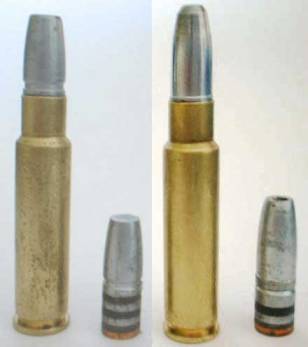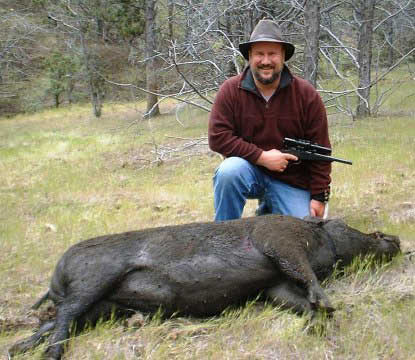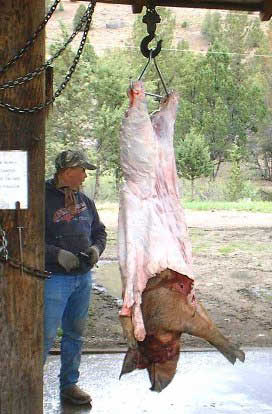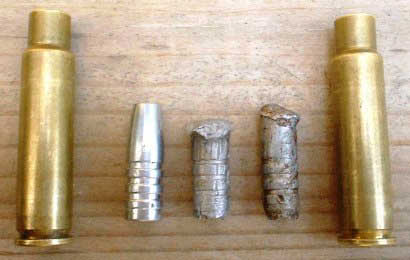|
Why does Man
hunt? That is not a simple question, and the answer is neither simple, nor
singular. There are many good answers, and with some hunters those answers may
change over time. There are several reasons that I hunt. I enjoy being outdoors.
I enjoy being with animals in their natural environment. I enjoy the pursuit,
crafting the stalk, the "thrill of the chase". I enjoy pitting my observational
skills and reason against the challenge of finding the game, and working to get
within range, unobserved and undetected. I enjoy learning from my mistakes,
knowing that they will make me a smarter hunter. I enjoy working for my meat,
and the sense of satisfaction that comes from having earned the meat that I put
on the table. I enjoy spending time with people that set goals, and then work to
make those goals happen. I enjoy using, and fine-tuning, quality tools -- like
guns, knives, cast bullets and handloads. As a young man, I looked forward to
the killing, as if it somehow offered proof of my virility as a predator at the
top of the food-chain; but as more and more gray creeps into my beard, I have
come to accept the killing as just a part of the equation -- no longer a
highlight, just another step in the process. Hunting is at the core of human
history and human progress, and I would no more deny myself the opportunity to
be a part of that experience than I would deny myself any of the other basic
human needs. In short, I hunt because I'm human.
Last fall was
unusual because a number of events conspired to keep me out of the hunting
fields by and large. Oh I got a little bird-hunting in, and I made one trip for
elk, but rather than spending virtually every free moment outdoors, gun in hand,
I was trapped inside civilization for those magical months of autumn. A spring
hunt was called for! I have lived in the Pacific Northwest now for over 20
years, but in many ways I am still a Southern Boy, and boy do I love barbecued
pork! I hadn't hunted wild hogs in a couple years, so I decided to treat myself
to a spring hunt for wild hogs.
A group of us have been getting together in the mountains of central
Oregon for a "Sixgunner Rendezvous" every summer for a number of years now.
We've got all types that show up for this gathering -- engineers, machinists,
preachers, consultants, and a couple of grizzled old retired coots thrown in for
spice. We set up a large camp up in the mountains and spend a few days plinking,
hiking in the mountains, socializing, and cooking all sorts of yummy stuff
(biscuits-n-gravy just don't get any better than freshly baked Dutch oven
biscuits with elk sausage gravy!). Every so often a few members of this group
get together to do a little hunting. For this hunt I would be hunting with
Steve, and Rob Applegate would be dropping in on us for a visit (but he wouldn't
actually hunt). We would be hunting on Clover Creek Ranch, a rocky, hilly
2200-acre ranch in central Oregon, with elevations ranging from 2700 feet to
over 4200 feet. Basalt outcroppings and junipers dominate the undulating
landscape. It had been a long, cool, wet spring, and the hills were greening up,
and the catch basins were full of water. The game trails showed heavy use.
Steve and I met up at the cabin and were chatting when Shane (the ranch
manager) pulled up. We got acquainted and Shane brought us up to date on recent
happenings around the ranch. Steve and I were both looking for meat hogs (can't
you just smell the barbeque?), and Shane filled us in on where the hogs had been
seen recently. Then we went in, fixed a quick dinner, told a few hunting stories
and hit the rack.
The next morning we were up at 5am, and pretty quickly the skillet was
sizzling with sausage (made from the boar Steve shot last year), with the coffee
pot gurgling in harmony. After a hearty breakfast, we headed out to hunt. We
drove up onto the top of a nearby finger-ridge, parked the truck, and got out to
devise our plans. We knew there was a catch-basin about a quarter mile down the
hill through the junipers, and Shane had told us that the hogs were hanging out
in that general area. I knew from previous experience that there was a shaded
hillside above that catch basin, where the soil stayed moist and the hogs liked
to root around in the soft dirt. So the plan was to send Steve down on a fairly
direct route down to the catch-basin, while I would swing wide to the west and
make loop down through the drainage and see if I couldn't kick anything out of
the bushes. After side-hilling to the west about a quarter mile, I started to
work my way down into the drainage. I broke into a small clearing and there was
what appeared to be a massive, sun-bleached log, roughly 18" in diameter, lying
beneath a cluster of junipers on the far side of the clearing. That "log" looked
very much out of place since the entire hillside is forested with junipers that
are no more than 15 feet tall and 6" in diameter, so I brought up the binocs to
get a closer look. Yup, it was a hog alright, a white sow that would easily go
over 500 lbs. Since Steve was hunting with an iron-sighted revolver, and wanted
to get good and close for his shot, I made note of the location in case he
wanted to take this sow.
It was about this time that the ruckus started. Down at the water hole
below, there erupted a cacophony of grunts, squeals, snarls and popping jaws. It
was obvious that there was a group of hogs down below us, and that some of them
weren't in the best of moods. Now things were getting interesting! I saw Steve
through a break in the junipers, about 200 yards to my right. We looked at each
other and waved, and started down towards the noise. We found a group of 6-8
hogs milling about around the catch-basin, most of which were in the 150-lb
class. It became apparent that a couple of them were sows in heat, and that the
randy young boars in the group were giving them no peace, hence the foul moods
and snapping jaws. There was also a larger boar, around 450 lbs, but since both
Steve and I were looking for meat hogs in the 200-300 lb class we looked this
group over and ultimately decided to pass them up.
We met up and discussed our options. I took Steve by and showed him the
bedded white sow, but he decided to pass since she was much larger than what he
was looking for. I had seen a few other hogs rooting around in the shadows below
the dam, and our group had moved off in that direction, so we decided to follow
them into the shadows.
We found the hogs down in the woods. Our group had picked up a few
stragglers and had grown in number. The 450-lb boar was trying to convince the
young sows that he was the boar of their dreams and that they really wanted to
bear his piglets, but they weren't buying it. The younger boars were also
trying, but having even less success. As the herd was drifting through the
woods, they eventually came to a stop at what was obviously their favorite mud
hole/wallow. During this whole time, the hogs were staying tightly bunched, and
it was hard to get a real good look at them to judge size and body type (and
impossible to get a clean shot). Once they reached the wallow, and it was clear
that they weren't going any further, we were able to move into a position on the
hillside about 35 yards above them, where we could study them at our leisure.
After careful observation, we decided that there were 3 that were in the
size range we were looking for -- a red sow, a black boar and a black boar with
a thin white stripe behind his shoulder. Steve had a hard time deciding which
one he wanted, so he asked me to pick which one I was going to take. I chose the
black boar. Steve was hunting with his Ruger Bisley Vaquero ("Bisquero") .45
Colt, and I had a scoped Contender, so I had more flexibility in terms of what
shots I could take. As a result, we had decided earlier that Steve would take
the first shot. Eventually, Steve decided on the red sow, and started to move
down the hillside to get into position for a shot. His 5.5" Bisquero was loaded
with the RCBS 45-270 SAA (a 285 grain SWC) over enough H110 to generate 1200
fps. His first shot hit her low in the shoulder, went though the brisket and
exited low through the far side leg. She was hit hard, but the wound was not
going to be immediately fatal, and she was still on her feet. His second shot
drove through her neck and put her down quickly. It was obvious from the way
that the exit wound was bleeding that the major vessels had been cut. During all
this, the herd had looked up, but instead of spooking, they had just gone back
to rooting around in the hillside and wallowing in the mud (that must have been
some really good mud!).
 |
|
The .338 GEF loaded with
the MM 235 (left) and the 33889 HP (right). |
|
Eventually, the 300-lb black boar worked his way out from the herd and
gave me a clear shot presentation. He was walking downhill away from me, angling
towards my left, so I lined up for a raking shot, to enter at the last rib on
the left side and break the front right leg upon exit. I was hunting with my
Contender, chambered in a wildcat cartridge that JD Jones and SSK Industries
helped me put together back in 1993. The .338 GEF is based on the .356
Winchester case, necked down to .338, with the shoulder angle blown out to 40
degrees. I had had Mountain Molds make a bullet mould specifically for this
cartridge/gun combination, a lovely 235 grain GC-FP with a .250" meplat, and I
was hunting with the most accurate load that I've found for it so far (44.5
grains of 4350 for 1700 fps), not a maximum load in terms of pressure/velocity,
but it's very accurate and I figured it was more than enough to hammer a hog. At
the shot, he started trotting downhill, obviously hit fairly hard, but still on
his feet and not showing any signs of going down soon. As I reloaded, he crossed
the creek and turned to the right to climb up the earthen slope out of the creek
bed. I was above him, shooting down, at a rather odd angle. I snapped the action
shut and touched off the shot as soon as I saw ribs underneath the crosshairs,
in an effort to keep him from escaping. This second shot hit him hard, and he
lost his footing and slid down, backwards, into the creek below. I scrambled
down the hillside, and dropped off my pack and Contender on the bank of the
creek. As I stood over the boar lying in the creek, admiring him, there were
several things that I noted -- a) the entrance wound for the first shot (last
rib on the left side) was not bleeding because it had some fat and meat pushed
out through the hole, plugging blood flow, b) that there was no blood coming
from anywhere on his body that I could see, only a little bit from his mouth and
nose (consistent with a lung shot), and c) that he was still breathing. By all
outward signs, he was unconscious and dying, but I drew my 629 just the same.
About this time, he started to wake up, and started to struggle (meekly) to
regain his feet. I cocked the hammer of the .44 Mag and sent a 429421 HP though
both of his lungs (23.5 grains of W296, 1350 fps). Again, there were several
things that were immediately obvious after the shot -- a) that this shot hit him
much harder than the first two, b) there was a geyser of blood coming out of the
entrance hole, c) that the shot exited, as I could see the blood coming from the
exit wound under him in the creek, and d) that he was dead moments later.
As we waited for Shane to arrive with the 4-wheeler to haul these hogs
out, Steve started telling me about my second shot hitting a branch that was
hanging down in front of the black boar, and watching wood fragments shatter in
all directions with the shot. I had no clue that I had hit a branch, I had fired
in a hurry to keep him from escaping, and then lost the sight picture in recoil.
Steve assured me that I had, and that it had been quite dramatic. He even poked
around on the creek bank and found the piece of branch that had a fresh .33
caliber bullet hole in it to prove it!
Shane came back and found us with his 4-wheeler, and got my hog pulled
up and out of the creek so we could take pictures, then he got him loaded up on
the trailer and hauled back to the skinning shed. Then he came back and repeated
the performance with Steve's red sow. We hiked back to the truck and drove back
down to camp for some lunch. It had been a good morning!
 |
|
Glen and the black boar. |
When we got back to camp, we found Shane and Angie working on our hogs,
and Rob was playing "stick" with their dog. As we stood around and got caught up
with Rob, Angie found one of my cast bullets, lying flat against the hide,
underneath the belly, about halfway between the sternum and the pelvis. From the
oblong shape of the hemorrhaged tissue surrounding it, it was obvious that this
bullet had come to rest going sideways. A little while later, she pipes up,
"Found another one!", this time in the right "armpit" of the boar. This one was
point-on, run headlong into the leg bone. After she finished skinning the boar
out, it was possible to track what had happened with each of the shots. The
first shot had gone right where I had told it to, entering at the last rib on
the left side, raking forward through the lungs, plowing into the right shoulder
just as I had intended. I would have expected this bullet at 1700 fps to break
the offside shoulder and exit, but there it was, you can't argue with the facts.
It is possible that this bullet may have clipped the paunch and that slowed it
down (the stomach had been hit, but it wasn't clear which bullet hit it). The
first shot penetrated about 30", and would have ultimately proven fatal, but it
wasn't doing its job all that quickly. The second shot entered sideways
in the upper rear portion of the right ribs, clearly destabilized from its
impact with the limb. The line of the second shot would have led it to exit low
in the center of the left ribs, but the tumbling bullet instead turned left and
down, coming to rest under the belly hide. The second shot penetrated no more
than about 18" before coming to rest. The 429421 HP finisher turned in its usual
stellar performance, leaving large entrance and exit wounds, both of which bled
freely. I really like the 429421 HP.
 |
|
Steve's red sow being skinned. |
The first shot traveled in a straight line and had gone exactly where I
wanted it to go. The recovered bullet weighed 201 grains. The second shot had
been a tumbling buzz-saw, and had turned and gone in oddball directions because
of this tumbling. The recovered bullet weighed 224 grains, and the nose shows
scarring from where it hit the limb.
I am convinced that if my first shot had been with a cast HP (like the
33889 HP that I used in the .338 GEF to shoot my last hog with) that this boar
would have gone down quickly and none of the other shots would have been
necessary. I have also done some experiments with the Mountain Molds 235 GC-FP
cast nice and soft to promote expansion (BHN = 9), and I think they would have
done a faster job than the moderately hard bullets I was using (BHN about 13). I
guess .33 caliber is just a little too small to be using "solids".
 |
|
Recovered bullets -- fired
.338 GEF cases, the MM 235 as-cast (left), recovered first shot (center),
and second shot (right) |
After lunch, we headed back out to go check on things up in upper parts
of the ranch. We found the buffalo, yaks, sheep and goats up by the catch-basin
up in the big meadow on top. Some of the buffalo bulls were really massive, and
we got some good pictures to take home with us. There were also a couple of
really handsome Corsican rams, and one nice Black Hawaiian ram that we got to
look over, any of which would look really nice hanging in my gun room. Maybe
next spring...
The next morning, we had a lazy morning, with more of Steve's sausage
sizzlin' in the skillet, scrambled eggs, toast and jam. We got out and hiked
around the ranch to see what we could see. It was an absolutely bluebird day! We
learned a few more things about the ranch and found hogs, Russian boar, water
buffalo, fallow deer and jack rabbits. It was one fine morning! Then we went
back down to camp, fixed lunch, packed our gear, and settled up with Angie.
After the meat was loaded up, we said our goodbyes and hit the road. It was a
good couple of days. We had hunted hard and hunted well, we had taken a couple
of fine animals that would make excellent table fare, we had spent quality time
with good friends, we had talked guns, knives and cast bullets with fellow
outdoorsmen who knew how to appreciate such things, and we had enjoyed the
beauty of Creation in ways that only a hunter can understand. In short, we had
once again refreshed our souls and reminded ourselves of why we hunt.
|